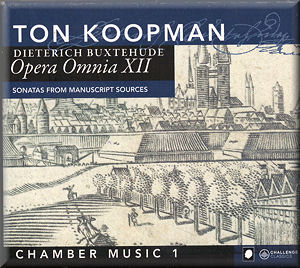 |
 |
|


alternatively
CD: MDT
AmazonUK
AmazonUS
Sound
Samples & Downloads |
Dieterich BUXTEHUDE (c.1638-1707)
Opera Omnia XII
Chamber Music I: Sonatas from manuscript sources
Sonata in C major for two violins, viola da gamba and basso continuo
BuxWV 266 [7:54]
Sonata in A minor for violin, viola da gamba and basso continuo
BuxWV 272 [6:50]
Sonata in D major for viola da gamba, violone and basso continuo
BuxWV 267 [7:54]
Sonata (with Suite) in B-flat major for violin, viola da gamba and
basso continuo BuxWV 273 [13:12]
Sonata in D minor for violin, viola da gamba and basso continuo
BuxWV Anh. 5 [2:58]
Sonata in G major for two violins, viola da gamba and basso continuo
BuxWV 271 [8:31]
Sonata in D major for viola da gamba and basso continuo BuxWV 268
[4:35]
Sonata in F major for two violins, viola da gamba and basso continuo
BuxWV 269 [6:53]
 Catherine Manson, David Rabinovich (violins); Jonathan Manson (viola
da gamba); Ton Koopman (harpsichord and organ); Mike Fentross (lute);
Christine Sticher (violone)
Catherine Manson, David Rabinovich (violins); Jonathan Manson (viola
da gamba); Ton Koopman (harpsichord and organ); Mike Fentross (lute);
Christine Sticher (violone)
rec. Waalse Kerke, Amsterdam, February 2010. DDD
 CHALLENGE CLASSICS CC72251 [58.50]
CHALLENGE CLASSICS CC72251 [58.50] 
|
|
|
This recording presents the eight unpublished chamber works
of Dieterich Buxtehude. As the excellently clear booklet notes
by Christoph Wolff explain, these pieces show a less uniform
scoring than those which were published in Hamburg in the late
seventeenth-century, which, Wolff speculates, may be a reason
for their relative neglect: the varied instrumentation by which
they are characterised made them less suitable for printing
as a set.
The commercial stringencies of the 1690s notwithstanding, these
are marvellously adventurous works in which all parts are given
equal prominence within the texture. The effect is of truly
three-dimensional Sonatas which, in this respect, foreshadow
the String Quartets of Haydn and, more especially, of Mozart.
They are here afforded performances of much understanding by
these fine musicians, whose careful consideration of the works’
compositional structures produces realisations which are full
of energy and vitality, shot through with light; but also of
great strength and authority.
The sophistication and artistry of the performers is immediately
evident from the first piece on the disc: the Sonata in C for
two violins, viola da gamba and basso continuo (BuxWV 266).
The sounds of the bowed string instruments are well enough differentiated
to enhance the counterpoint, but similar enough to ensure an
integrated sound. The bow is used primarily as an expressive
medium; and subtly shaped phrases and finely graded repeated
notes serve top enhance the structure of the melodic lines.
Nuanced playing is also characteristic of the Sonata in A minor
for violin, viola da gamba and basso continuo (BuxWV 272) that
follows, the violin and viola da gamba complementing each other
admirably; this Sonata is also notable for its incisive rhythmic
control and employment of virtuosic bowing techniques, which
are effortlessly applied.
The continuo is brought more to the fore in the following two
Sonatas: and the fuller harmonic background appears to stimulate
an even more heightened response in terms of the shaping of
melodic lines. The Sonata in B-flat (BuxWV 273) features some
especially fine lute playing in the first movement, which lends
an air of Mediterranean exuberance to the work. Indeed, the
use of the lute is particularly successful in all the works
presented on this disc, as it provides a piquant contrast to
the chamber organ and, even in those works in which the harpsichord
is used as the keyboard continuo instrument, the sound is sufficiently
different to allow for interesting and, at times, dramatic changes
of colour; which are, however, never employed gratuitously,
but always with regard to the formal structure of the music.
The continuo instruments are also recorded with enough clarity
and afforded enough prominence to enable both horizontal and
vertical components of the part to be clearly heard.
The booklet is clearly presented with, as has previously been
mentioned, extremely informative and well-written notes. Each
work on the disc is presented on one track – the individual
movements are not separated by track breaks – which means that
each Sonata is given as a single entity, and is clearly intended
to be listened to as such. The only – very minor – quibble is
that the single violinist in the works for violin, viola da
gamba and basso continuo (Tracks 2, 4 and 5) is not identified.
This is an extremely intelligent, convincingly performed and
well-packaged disc, which stimulates the listener to investigate
further the chamber music of this relatively little-known, somewhat
overshadowed composer. It presents all that musical performance
at its best should involve: a cerebral, authoritative approach;
a demonstrative realisation; and a performance that has a zest
of life, freshness and vigour.
Em Marshall-Luck
|
|

